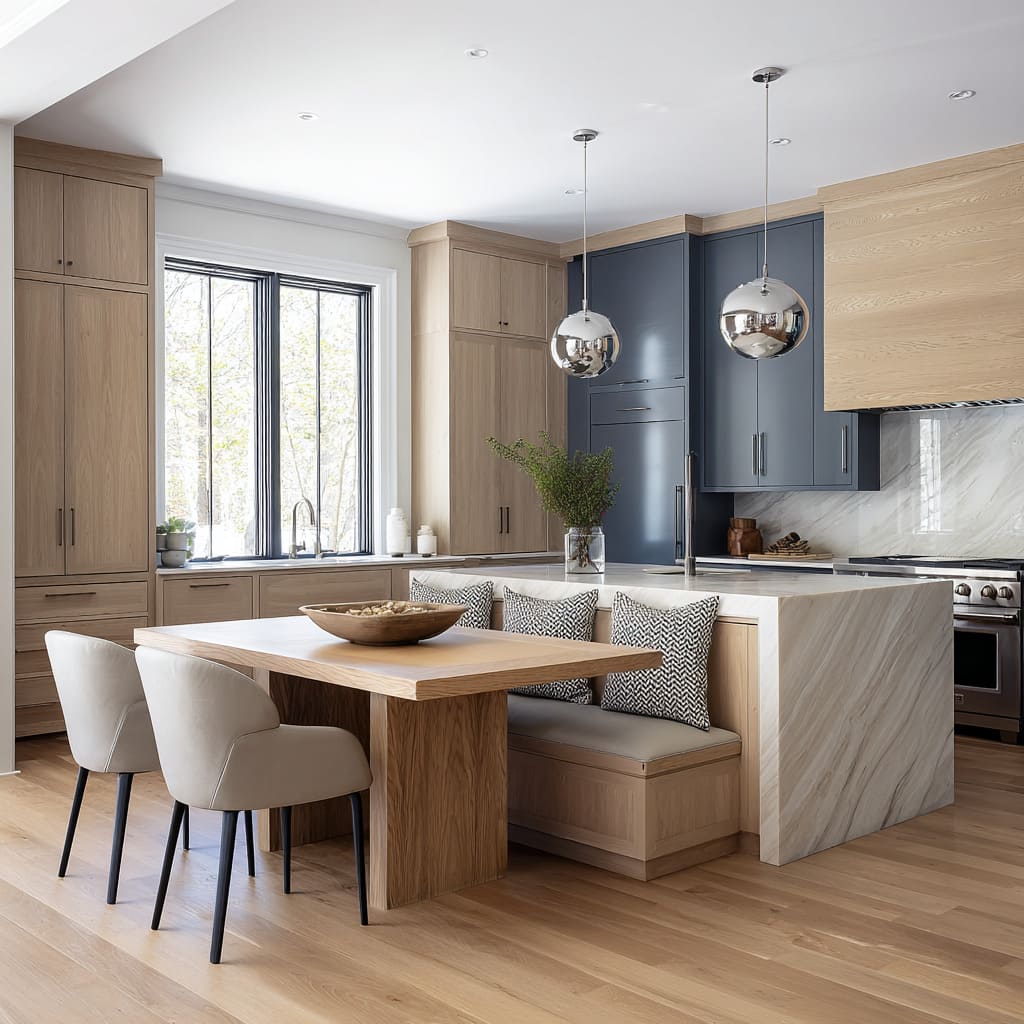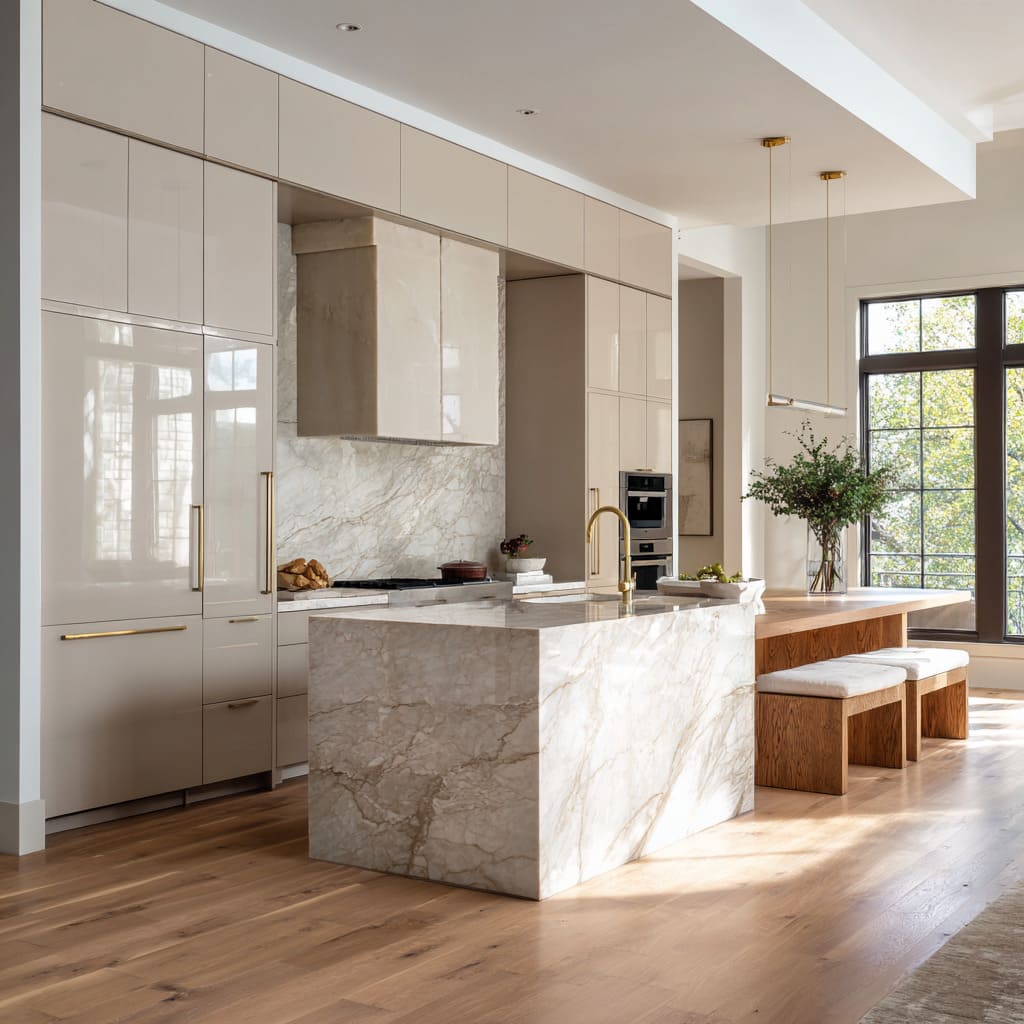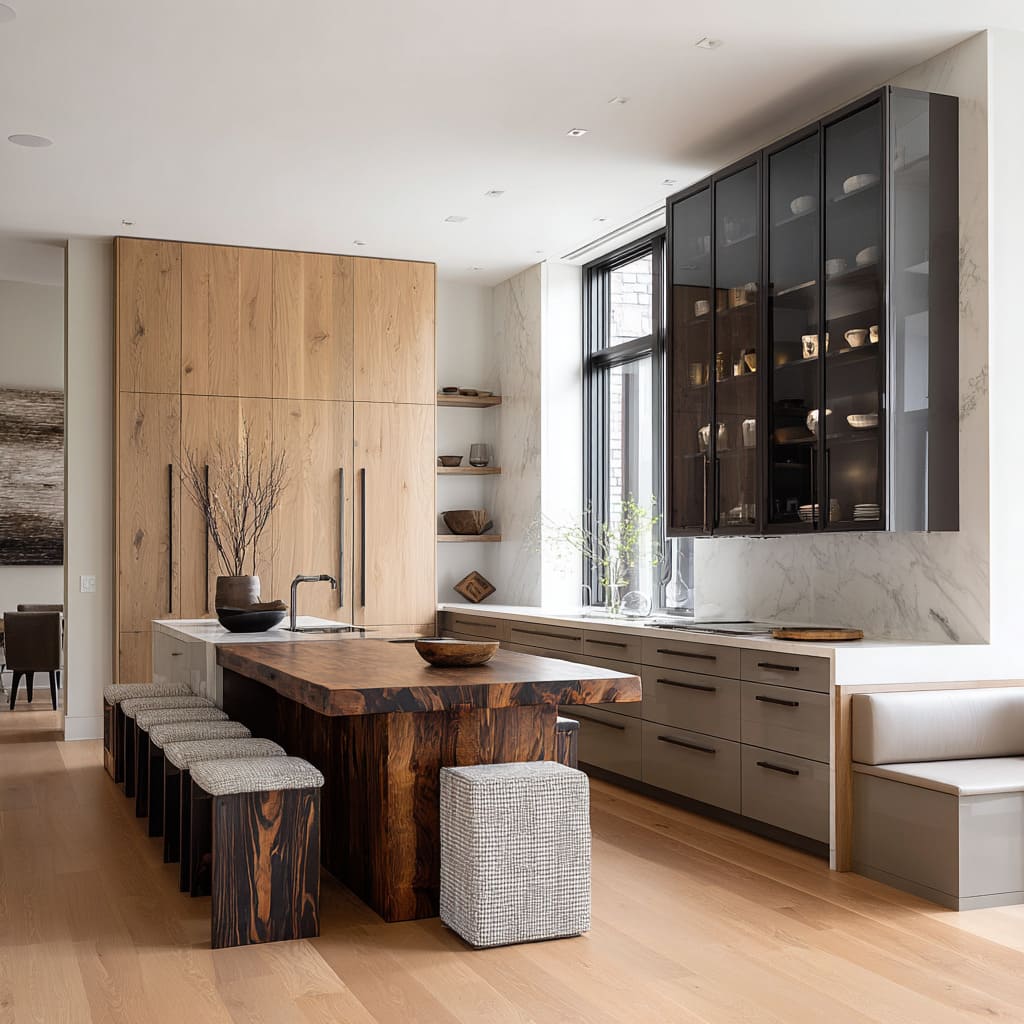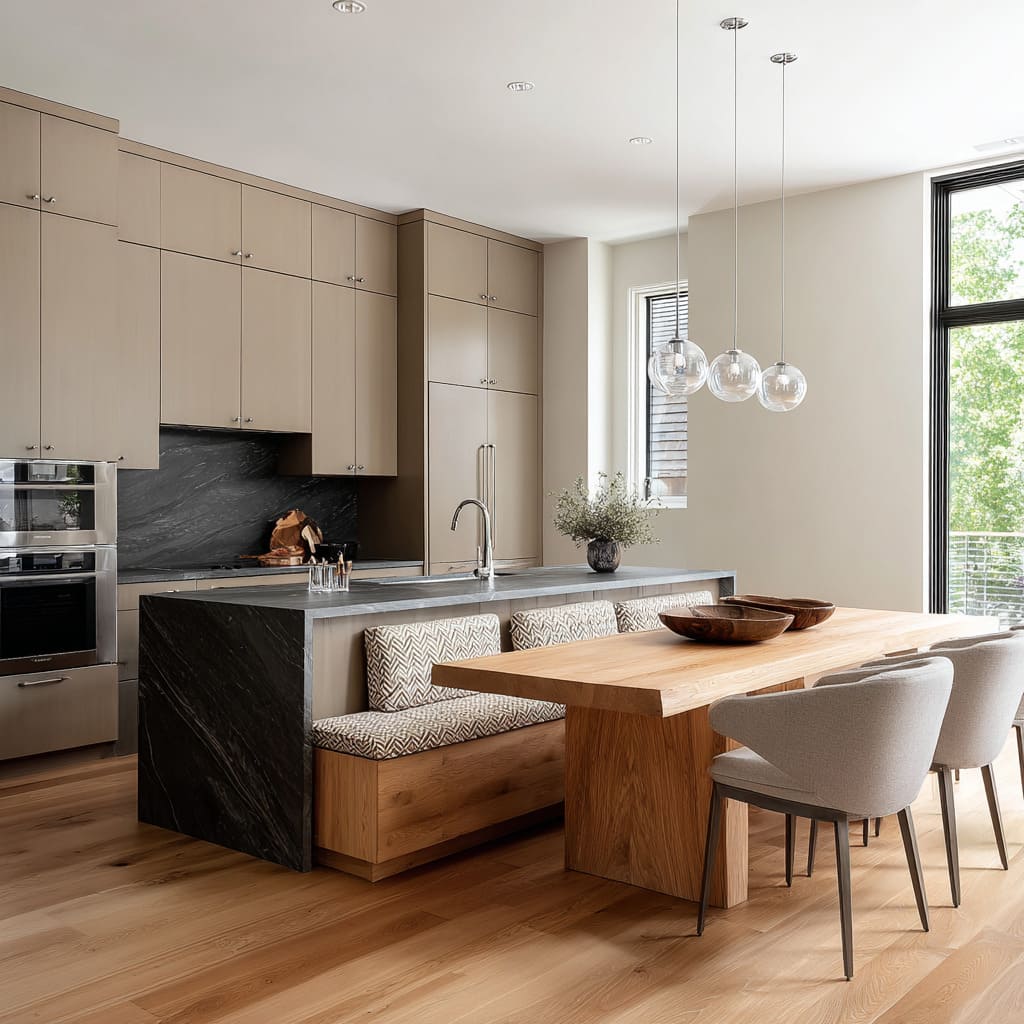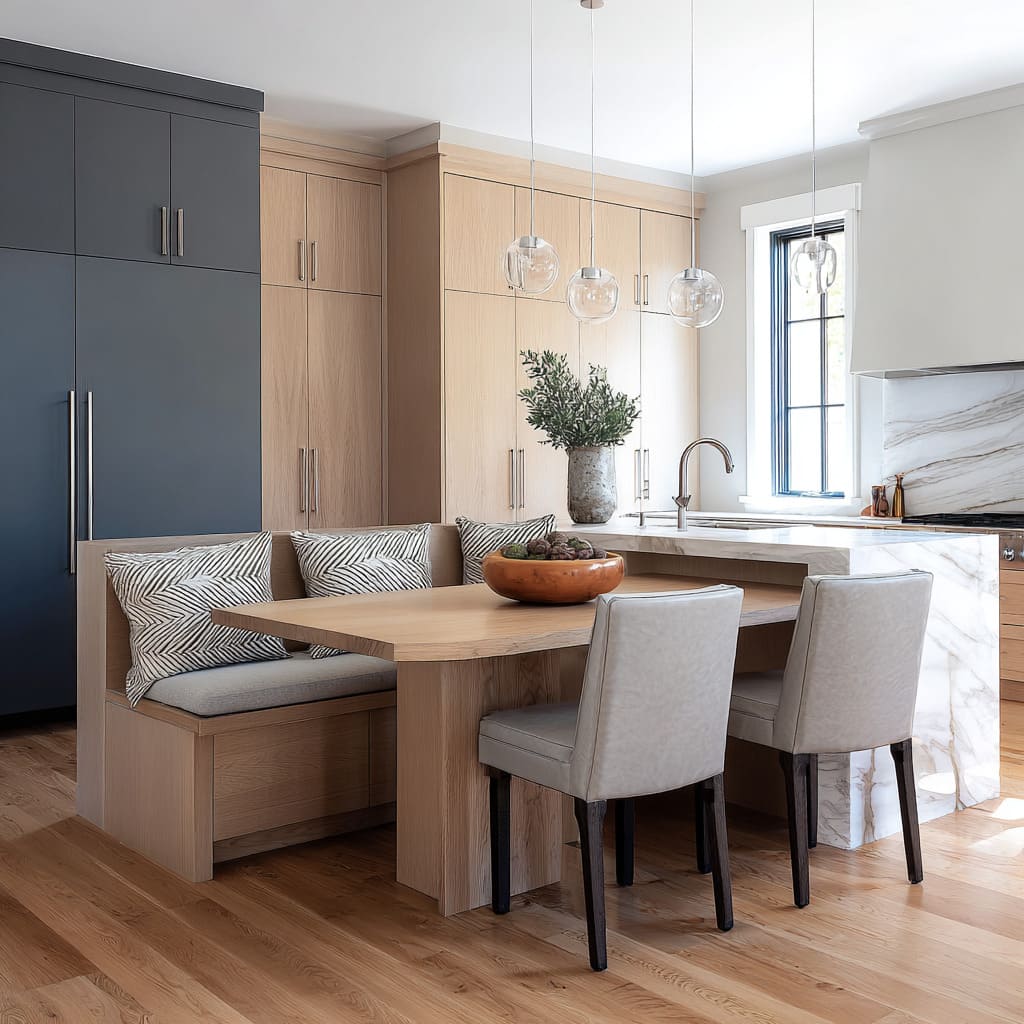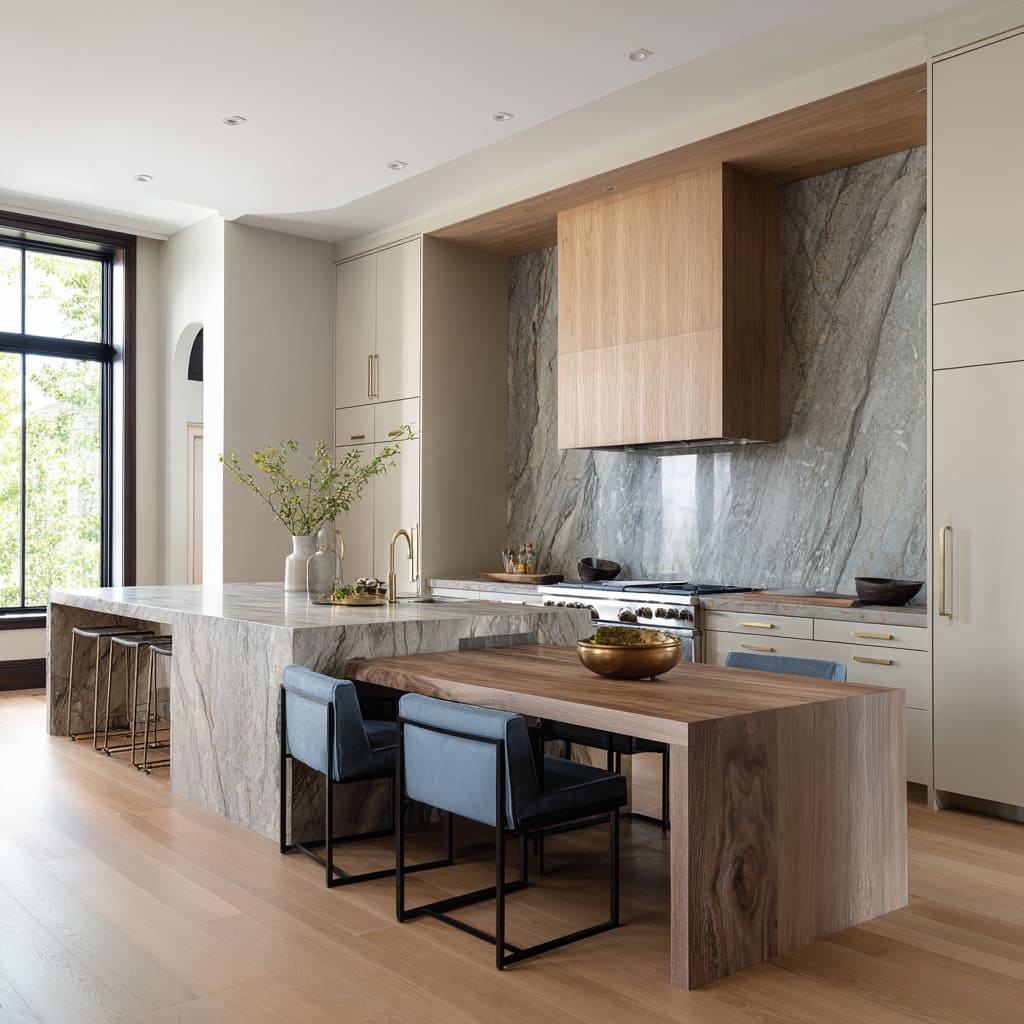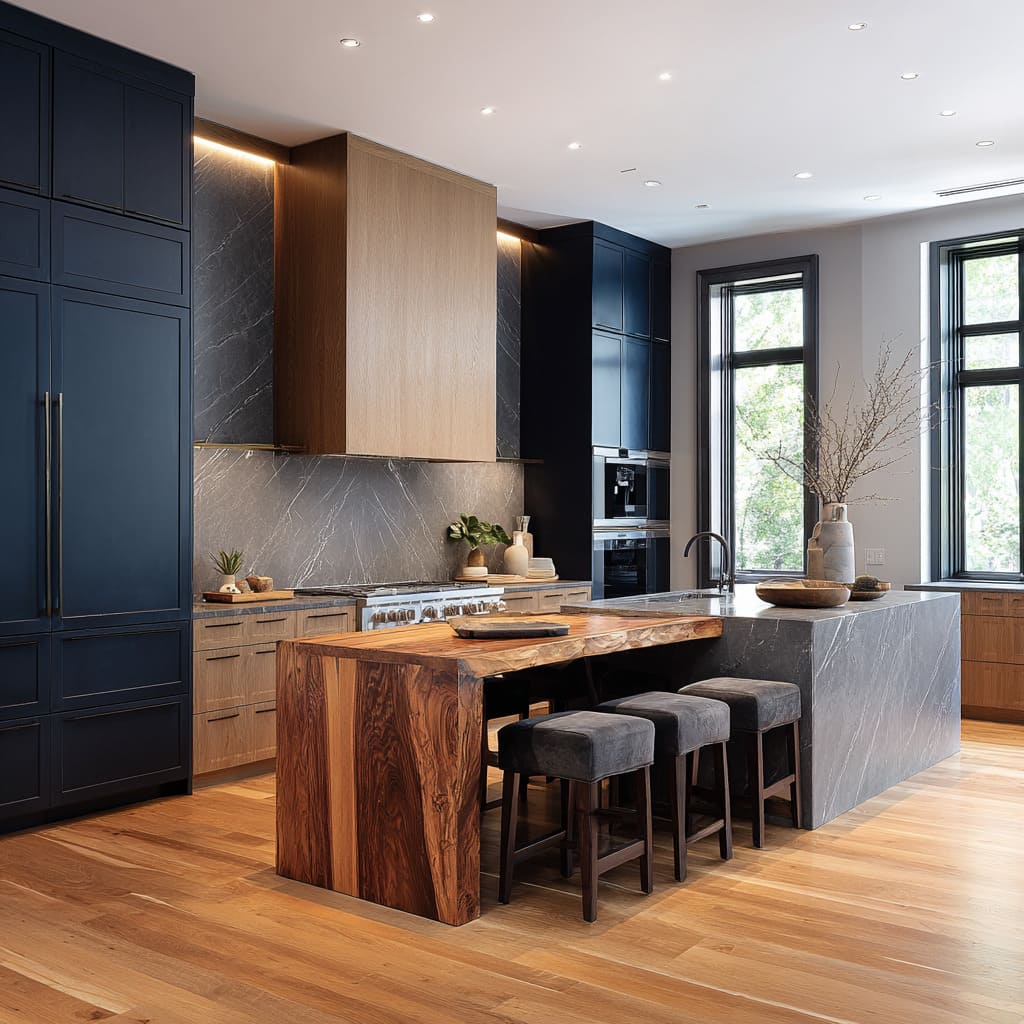Modern kitchen designs often use an island and dining table partnership as a quiet dialogue between architectural elements and furniture-like comfort. One surface carries the weight of the working zone, while the adjoining table behaves like a social anchor with softer forms, calmer textures, and warmer tones.
In many kitchen islands with dining table design concepts, this pairing relies on contrast instead of similarity: stone waterfalls create a sculpted, monolithic presence, while oak or walnut introduces a more human scale. Differences in thickness, grain intensity, table height, and edge profiles help the eye understand the transition from tool to gathering surface.
This division becomes especially clear when stone veining runs like a long current toward the table, or when the wood slab shows cathedrals and figured streaks that feel expressive and domestic. The result is a visual duet—one part steady and architectural, the other tactile and sociable—without ever needing a separate room for dining.
Seating Typologies
Seating shapes and spacing reveal how the kitchen design expects people to interact. This becomes especially evident in kitchen island dining table combo ideas, where stools, benches, cubes, and host chairs create a rhythm of closeness or spaciousness.
They use these seating choices as a social diagram:.
Three common seating patterns
- Continuous line seating: tightly spaced stools mimic a bench, ideal for casual moments and shared conversations.
- Mixed seating: benches on one side and individual stools on the other introduce tempo—soft continuity versus playful punctuation.
- Lounge-like dining chairs: deeper silhouettes opposite a built-in banquette define zones for extended meals or slow mornings.
Texture and tone
Bouclé benches soften long runs of stone. Powder-blue or pale-gray upholstery calms bold grains.
Tweed cubes bring micro-pattern energy without crowding the space. Seating becomes a character-defining tool—light and airy in some kitchens, grounded and moody in others—quietly shaping the emotional flow of the room.
Lighting as the Boundary Between Work and Warmth
Light placement is one of the strongest visual organizers in kitchen ideas with islands and dining tables, shaping atmosphere without adding physical dividers. Over the prep zone, small ceiling points or thin fixtures stay crisp and functional; over the dining table, pendants drop lower to create a soft pocket of intimacy.
Many designs rely on clear glass globes that hover above the seating area, allowing reflections of stone, wood, or window views to shimmer gently. In some schemes, the pendants align directly over chairs, benches, or table centers, creating a subtle grid of social positions.
In others, the lights hang at slightly different heights to relax an otherwise linear composition. Reflective spheres amplify warm material tones, while smoked-glass shades double the interior as faint silhouettes.
This careful lighting choreography helps the table feel like a place to linger, while the island remains the visual backbone for cooking, plating, and day-to-day flow.
Banquettes and Built-In Corners That Act Like Home Cafés
Many kitchen designs evolve their island into a corner designed for slow, comfortable meals—an idea that can be used in modern kitchen design with island and dining table layouts. Banquettes with recessed plinths appear to hover, creating a visual lift even when built of robust oak.
Cushion patterns often echo stone veining with chevron or zigzag micro-motifs, tying the textures of the design together. These built-in nooks use continuous horizontal lines—bench seat height, table-top thickness, or hood alignment—to stitch the prep zone and dining zone into a unified whole.
The effect resembles a café tucked inside a home, where the seating feels custom, intentional, and closely tied to the architecture of the island. Light fixtures compress the atmosphere over the bench, while the table’s generous overhang maintains comfort without heavy mass.
This banquette-based island dining table ideas merge efficiency and intimacy in a way that feels natural rather than forced.
Background Cabinets as Stage Sets for the Island–Table Composition
The backdrop behind the island-table composition is just as important as the hybrid itself. In sophisticated kitchen island and dining table design ideas, the cabinetry often behaves like a quiet stage set.
Tone-blocking between tall oak panels, graphite storage blocks, and pale greige drawers creates rhythm without stealing focus. Glass-front cabinets introduce soft glow boxes where tableware becomes part of the aesthetic story.
Hoods wrapped in warm oak sit like central anchors, framed by tall towers on either side. Hardware stays slim and low-sheen to avoid visual noise.
Such cabinets do not compete with the island-table unit—they frame it. Window mullions often repeat the color of stool legs or table bases, tying the perimeter to the center.
When the island carries bold veining or expressive grain, the backdrop intentionally steps down in intensity, allowing the hybrid unit to remain the room’s main character.
Stone and Wood as Emotional Atmosphere Makers
Stone and wood are more than materials in modern kitchen island dining table ideas; they behave as emotional ingredients. A cool, blue-gray slab with sweeping diagonal veins introduces quiet movement, like tide lines or coastal air.
Live-edge walnut brings warmth and grounded temperament, especially when its end grain is exposed at the table leg. Charcoal stone with lightning-like veining gives a kitchen dramatic tension, softened by oak tables that extend from the island like warm invitations.
When stone and wood are perfectly aligned—waterfall edges matching table pedestal thickness, grain lines flowing toward seating zones—the entire room feels interconnected. When they contrast strongly—busy stone against calm wood or vice versa—the eye oscillates between the two, creating a layered atmosphere that remains balanced and composed.
These dynamics appear again and again in thoughtful kitchen island ideas with dining table arrangements where mood, not color, becomes the guiding force.
Circulation, Eye Movement, and the Story of Flow
Even without touching spatial layout, the visual flow carries extraordinary influence in a modern kitchen island with attached table ideas. They script how the eye travels: floorboards run parallel to the island to stretch the volume; stone veining arcs gently toward the table to signal the handoff between work and gathering; long drawer lines create uninterrupted horizontals that keep the table area calm.
Vertical moments—tall branches in a vessel, a brass faucet arc, the band of an oak hood—bookend these horizontals so the dining table doesn’t float visually.
Negative space around stools and chairs controls breathing room. Recessed toe spaces lift heavy blocks so they feel lighter.
Even the placement of a low bowl or the angle of a leaning board plays a role in easing the eye across the hybrid. The table becomes the room’s social punctuation mark, supported by a full grammar of grain, light, rhythm, and shadow—a composition approach that defines high-level kitchen island dining table ideas in contemporary styles.
The Island–Table Hybrid as a Unified Gesture in Modern Design
In many contemporary design concepts, the island-table combination reads as one long gesture—a sculptural line that transitions from cool stone to warm wood, from vertical geometry to soft seating clusters. These moments define the heart of the kitchen design, especially in larger open plans where furniture and architecture must cooperate.
When this gesture is handled with nuance, the result feels refined rather than decorative.
Glass pendants float in alignment with chair placement, drawers step down in height to soften corners near the table, and centered faucets reinforce axes that run from window to island to bench. These gestures create an environment where the hybrid functions not only as a practical extension of workspace but as the main social stage of the room, representing the fullest expression of modern kitchen island and dining table ideas and the evolving culture of open interior living.
The Power of Edge Profiles and Offsets
The joint between island and table carries the emotional tone of the space. Crisp right angles communicate quiet order; soft radii hint at ease and fluid movement; live edges bring controlled irregularity that loosens strict geometry.
They often let the table’s underside sit slightly recessed, creating slender shadow lines that make the top feel lighter. Chamfers along stone edges absorb glare and soften dark surfaces, and eased corners keep mass from feeling severe.
Even tiny offsets play a role: when a tabletop projects just beyond the stone waterfall, the slight misalignment reads as a gentle exhale in an otherwise disciplined block. These micro-decisions create a layered personality—part sculpted object, part low-profile dining zone working seamlessly within the kitchen envelope.
Conclusion:
Taken together, such kitchen design concepts reveal a thoughtful language of soft transitions, crafted edges, lighting pockets, expressive wood grains, and stone surfaces used as quiet currents. Each detail—whether a recessed plinth, a floating glass cabinet, or a sequence of stools arranged like notes in a scale—contributes to a cohesive whole.
This creates a complete world where work surfaces and gathering zones are woven into a single sculptural arrangement with kitchen island dining table ideas. Instead of dividing cooking and dining, the hybrid celebrates their proximity, creating rooms that feel composed, expressive, and socially attuned.



